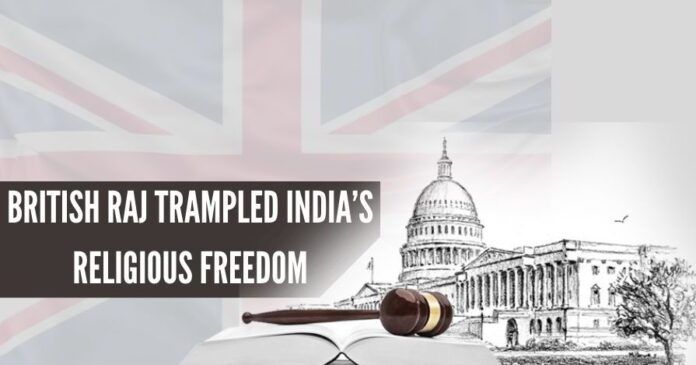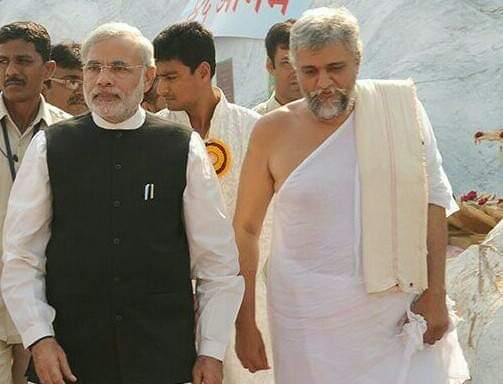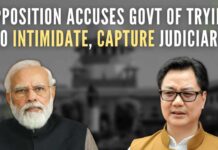
The scope of religious rights have been narrowed significantly and strangulated to a greater extent by making restrictive interpretations. This was evident in Sabrimala judgement
In India, large scale conversions to Christianity and Islam by any lure are still not ‘illegal’ but the practice of ones’ own religion, mainly Hinduism, as per the ancient Vedas and scriptures is under severe attack. The Sabrimala case, which the Supreme Court (SC) has taken up for review, is a classic example of this ‘bigotry.’ But how is that religious freedom in India for mainly those religions that were part of the country and imbibed into its cultural ethos, much before the invasion by Mughals (Islam) and British (Christian), came to be tampered with?
A study by Jain Acharya Shri Yugbhushan Surishwarji says that the key reason for religions’ born in India being shackled and chained lies in Article 25 and 26 of the Indian Constitution.
In an open letter recently to the Chief Justice of India’s Supreme Court Sharad Arvind Bobde, the Acharya Shri Yugbhushan Surishwarji has highlighted that Article 25 and 26 of the constitution were mainly borrowed from the concept of ‘Christianity’ and lacked “any relation to religions with Indian orientation.”
“As a Dharmacharya, it is painful when, by judicial pronouncements, the ‘Supreme God’ or ‘Deity’, a spiritual and temporal sovereign, as legal personality, is subjected to temporal and secular jurisdiction and is further met with derision by tagging it as “perpetual minor”, “mentally incapable”, and “disabled,” the letter to the Chief Justice says.
It is this reason that the State and judiciary’s interpretation of the culture and practices of Indian origin religions is not in sync with the beliefs of non-Christian religions. The Acharya says that “Post-independence, as precedents set by the British, while framing the constitution, the Constituent Assembly unilaterally assumed the authority over religions and framed Article 25 and 26 without consulting all religious heads in the country.”
“Article 25 and 26 of Indian Constitution were borrowed from Article 44 of the Constitution of Ireland, which deals with the aspects of religions, majorly Christianity, in Ireland. Foreign phrases incorporated in Article 25 and 26 were neither defined nor explained, which rendered ambiguity over its application. Given the existence of diverse religions and their practices and beliefs, both these articles were bound to face the challenges of application. Above referred incorporation in Article 25 & 26 was the first major action post-independence, whereby foreign framework was forcefully thrust upon Indian religions. Even though Article 25 and 26 were to protect fundamental religious rights, they were made subject to, a plethora of restrictions. These restrictions were not only limited to public order, health or morality but also in case of rights in Article 25 were made subject to other provisions of Part III. Additionally, the rights were further significantly restricted by conferring powers to State to regulate and restrict all financial, economic, political and other secular activities ‘associated with religious practices’ (which have been later interpreted very broadly). The state was further empowered to overrule religious scriptures and control religious practices in the garb of social welfare and reforms. Even, administration and management of religious properties were made subject to the power of Legislation (which have also been interpreted very broadly). Consequently, religions and their rights and privileges did not get any significant protection under these articles and remained at the mercy of State to get their due justice,” the letter to the Chief Justice says.
A key issue is that even without defining ‘religion’, the laws are enacted to control, restrict, and regulate the same. Despite that, it is claimed that ‘religious rights’ are protected under Article 25 and 26 of the Indian constitution. There is a necessity of harmonious interpretation of the terms (i) ‘religion’ mentioned in ‘matters of religion‘ in Article 26 as well as mentioned in Article 25 and (ii) ‘religious denomination’, keeping with the fact that it will be used mostly in relation to Indian Oriental Religions. This will help appropriate, unambiguous and distinguished interpretation of Article 26 as a whole including the ‘matter of religion’.

Vesting of Rights under Article 26
The research by Acharya Shri Yugbhushan Surishwarji shows that it is unclear as to where the rights protected by Article 26 vest. Notably, unlike the religious rights in Article 26, other fundamental rights in the constitution vest indefinite legal personalities i.e. person, citizens etc. As a matter of facts in the religious field, apart from the ‘deity’ no other legal juridical entity has been recognized. ‘Religion’ (which is not defined either in Constitution or by the Apex Court) and ‘religious denomination’ is not recognized even though many artificial legal personalities have been recognized in Indian jurisprudence including society, corporation etc.
Further, the study says that there is no proper legal framework or legal machinery to exercise, enforce and challenge rights for ‘religion’ and ‘religious denomination.’ It is in the absence of such legal recognition or any such framework, the ‘religion’ cannot enforce its legitimate and valid rules upon its followers. In the same manner ‘religious denominations’ are also unable to enforce the same.
Generally in India, although even the legal status of ‘Trust’ is ambiguous, trustees enjoy the power in the religious field in an ad-hoc manner. In this premise, the trustees may impose new rules upon the followers which maybe even against religions and religious denominations, provided they are not contravening the Trust Deed itself.
“As a Dharmacharya, it is painful when, by judicial pronouncements, the ‘Supreme God’ or ‘Deity’, a spiritual and temporal sovereign, as legal personality, is subjected to temporal and secular jurisdiction and is further met with derision by tagging it as “perpetual minor[2]”, “mentally incapable[3]”, and “disabled[4],” the letter to the Chief Justice says.
“In the recent Sabrimala judgement, the scope of religious rights has been further narrowed down by subjecting it to the additional test of constitutional morality coupled with the existing narrowed ‘essentiality test’ of the religious practice. As a result, protection provided to even essential religious practices under Article 25 and 26 is now considerably insignificant with maximum powers vested with the Courts to decide its applicability,” the letter to the Chief Justice said.
International scenario on legal recognition of religion
The study says that globally the Holy Seer is recognized as an international juridical personality, which is independent of the criterion of territorial sovereignty. Whereas in the case of ‘Dharmas’ and ‘Dharmik Sampradays’ of India, let alone in international jurisprudence, even in Indian jurisprudence, they have not been recognized as independent juridical personality.
It is also necessary to look at the benchmark document containing minimum international standards in the area of recognition of religious or belief communities[5]. It has been mentioned in the said benchmark document that access to legal personality for religious communities should be quick, transparent, fair, inclusive and non-discriminatory.[6] Further, the process of obtaining legal personality status should be open to as many communities as possible, without excluding any community on the grounds that it is not a traditional or recognized religion or through excessively narrow interpretations or definitions of religion or belief[7]. And that, a refusal to recognize it as a legal entity has also been found to constitute an interference with the right to freedom of religion under Article 9 of the ECHR as exercised by both the community itself and its individual members[8]. At the same time, under international human rights law, religious or belief communities should not be obliged to seek legal personality if they do not wish to do so. The choice of whether or not to register with the state may itself be a religious one, and the enjoyment of the right to freedom of religion or belief must not depend on whether a group has sought and acquired legal personality status.[9] It is a matter of grief that though as per international standards a ‘religious community’ should be given liberty to obtain legal juristic personality; in India, for a ‘religious community’, let alone such liberty, there is no framework for legal juristic existence even after 70 years of independence,” the letter to the Chief Justice said.
According to the Acharya Shri, the framing of constitution post-independence was a good opportunity to reset the historical wrongs been carried out by British Raj to various religious rights in India. The said opportunity could have been capitalised to reinstate the real status of religion, as was in ancient India. Unfortunately, the opportunity was lost and only the husk of it was achieved in the Constitution. Today the situation is such that whilst there is assumed protection of religious practice in Article 25 and 26, real protection can be tested only when the practice is adjudicated.
“Today although India became a democratic republic State, it is regrettable that religions here are not provided with opportunities to flower and flourish democratically.”
Historical religious sovereignty
In 1215, when the agitated barons of England and Bishops of English church got signed ‘Magna Carta’ they made sure that in any circumstance the English church should enjoy absolute freedom from the state. The very first clause of ‘Magna Carta’, as promised by King John, states that,
“I. FIRST, We have granted to God, and by this, our present Charter has confirmed, for Us and our Heirs forever, that the Church of England shall be free, and shall have all her whole Rights and Liberties inviolable. We have granted also, and given to all the Freemen of our Realm, for Us and our Heirs for ever, these Liberties under-written, to have and to hold to them and their Heirs, of Us and our Heirs forever.”
It is worth noting that, even today, of 63 Clauses signed in 1215, this clause of ‘Magna Carta’ is one of only four alive clauses and is enjoying the status of the constitutional law of England.
On 4th October 1965, Pope Paul VI, as a permanent observer at the United Nations, very humbly yet decisively asserted the necessities of temporal sovereignty in himself to carry out spiritual missions. In his words he said:
“…temporal sovereignty – the minimum needed in order to be free to exercise his spiritual mission and to assure those who deal with him that he is independent of any sovereignty of this world.”
(emphasis supplied)
Even the person of this stature, who enjoys absolute power in his sphere i.e. absolute spiritual sovereignty, feels the necessity of temporal sovereignty for spiritual missions.
The study by Acharya says that today in the United Kingdom, religion enjoys temporal and spiritual sovereignty. The Measures (Act) of English Church enjoy invulnerability from challenges like secular parliamentary legislations, and at times The Church of England can even opt-out of secular legislation.
In West-Minister Parliament, which is the mother of all Parliaments, religious heads (Bishops) enjoy reservations in the upper house of Parliament allowing their interference in secular affairs of the country. Few of other western countries enjoy the complete separation of State and Church as a matter of Constitutional law[1]. Even a few others enjoy non-interference of the state into religion.
“By quoting the above-stated facts, without any prejudice, I wish to draw your attention that even though India is the founder of all oriental religions, the religions here do not enjoy even religious autonomy and are a victim of frequent state interference post-independence,” the letter to Chief Justice said.
Interpretative Journey Post Framing of Indian Constitution
The study says that apart from the explicit restrictions to rights of religion, as worded in Article 25 and 26, the residual religious rights were further narrowed down by stricter interpretation of the said provisions. The first such challenge was faced in 1954 when seven judges constitutional bench of the Apex Court was formed to decide the matter in Shirur Mutt case.[10]
Interpretation of “Religious denomination”
While interpreting Article 26, ‘religious denomination’ was interpreted from Oxford dictionary rather than looking at the Indian context by referring to the Hindi translation of the Indian Constitution which mentioned the term ‘dharmik sampraday’ for ‘religious denomination’. In the Indian context, it would have been appropriate to consider this Hindi term taking into consideration religious scriptures and tenets, which could have been wider, pragmatic and acceptable approach to all Indian religious traditions.
Essential religious practices
The same Shirur Mutt case was also faced with the challenge to identify the practices which were protected by Article 25 and 26. Here, the word ‘essential’ was employed and inserted for the first time for religious practice. The whole idea of using the word ‘essential’ was only to separate the secular affairs and religious affairs with no other implied effect to the term and even the ‘essential’ religious practice was also to be only determined by the reference to the doctrines. However, this term was then begun to be used in a fixed manner.
Post that, in Ajmer Dargah case[11] and Tilkayat case[12], Apex Court although apparently accepting the judgement in Shirur Mutt case, added a word of caution and assumed the powers to determine religious practices as ‘non-essential’ on the basis that these are superstitious or irrational.
While the intention may have been good in Shirur Mutt judgement, unfortunately later on, the reference of the word ‘essential’ to the religious practices has been interpreted in a very restrictive way. In all the judgements post-Shirur Mutt judgement (barring few judgements) till date, only those religious practices which are very inherent to the existence of religion are considered as ‘essential’ while the religious practices which are supportive, complimentary, optional or residual in nature are ‘non-essential’ (virtually ‘secular’ if read with Shirur Mutt Case) to get protection under Article 25 and 26. To worsen it further, the meaning of ‘essential’ is considered as a practice which is perpetual (continuous).
“In the recent Sabrimala judgement[13], the scope of religious rights has been further narrowed down by subjecting it to the additional test of constitutional morality coupled with the existing narrowed ‘essentiality test’ of the religious practice. As a result, protection provided to even essential religious practices under Article 25 and 26 is now considerably insignificant with maximum powers vested with the Courts to decide its applicability,” the letter to the Chief Justice said.
Religious protection under Article 25 and 26 were of no avail since Article 25 was anyway subject to other provisions of Part III, and Article 26, as described above, had limited accessibility.
Interpretation and effect of other provisions on Article 25 and 26
The study says that religions in India since ages were affluent and resourceful because of the strong religiosity of devotees. Thus, they were always able to play the role of enabler in social, moral, and spiritual welfare.
However, it was with the advent of the British and even in Independent India, law framers have enacted many laws resulting in the declination of religious assets including movable and immovable properties leading to a reduction in the spread of social, moral and spiritual values. Large land parcels owned by religions including quarries, mines, forests were all subjected to land reforms, acquisition, land ceiling or forest laws. This resulted in acute depletion of the assets of religion/religious denomination including reserve funds with the religious institutions, losing trillions and trillions of wealth. On the other hand, religious protection under Article 25 and 26 were of no avail since Article 25 was anyway subject to other provisions of Part III, and Article 26, as described above, had limited accessibility. Even if Article 26 could have been invoked, Article 31 (A) (B) and (C) are strong enough to nullify its protection. Also, it may be noted that part of Article 26 has been held not forming part of the basic structure of the Constitution[14] making it further vulnerable to constitutional amendments.
“As of now, when we observe the history of interpretation of fundamental rights, it was noted that all other fundamental rights except religious rights have expanded in their respective scope. For instance; the scope of the right to life has expanded to include right to have a dignified life, right to live for unborn life; the scope of the right to privacy, equality and freedom of speech and expression has been significantly expanded. However, conversely, the scope of religious rights have been narrowed significantly and strangulated to a greater extent by making restrictive interpretations. This was evident in Sabrimala judgement of November 2018,” the letter to Chief Justice said.
Note:
1. Text in Blue points to additional data on the topic.
References:
[1] Church Autonomy in the United Kingdom – by MARK HILL
[2] Bishwanath And Anr vs Shri Thakur Radhaballabhji & Ors on 6 February 1967 IndianKanoon.org
[3] Kalanka Devi Sansthan vs Maharashtra Revenue Tribunal, on 19 August 1969 IndianKanoon.org
[4] Smt. Pramoda Das (Dead) Through vs Saroj Kanta Misra & Others on 27 June 2018 IndianKanoon.org
[5] Guidelines on the Legal Personality of Religious or Belief Communities
[10] The Commissioner, Hindu … vs Sri Lakshmindra Thirtha Swamiar on 16 April 1954 IndianKanoon.org
[11] Khyerbari Tea Co. Ltd. & Anr vs The State Of Assam on 13 December 1963 IndianKanoon.org
- Elon Musk postpones India visit. Non-clarity in Tesla partner and Starlink license might be the reasons - April 20, 2024
- NIA confiscates Pak-harboured Khalistani terrorist Lakhbir Singh Rode’s key aide’s land in Moga - April 19, 2024
- Prime Minister Narendra Modi: A Gujju businessman who does not invest his precious time for a losing battle - April 13, 2024











This section of the Constitution of India was not a “British” Imposition, far from it, it was Bhimrao Ramji Ambedkar.
Ambedkar and his drafting committee knew that to maintain the rule of law in such a diverse state, India’s newly found freedom needed to be accompanied by justice and equality.
The new federal, democratic republic established religious freedom as a fundamental right, providing for “freedom of conscience and the right of all individuals to freely profess, practice, and propagate religion; mandating a secular state; requiring the state to treat all religions impartially; and prohibiting discrimination based on religion.”